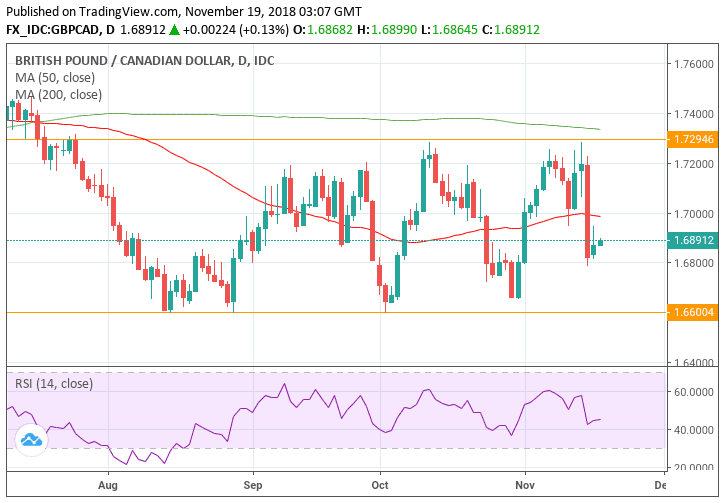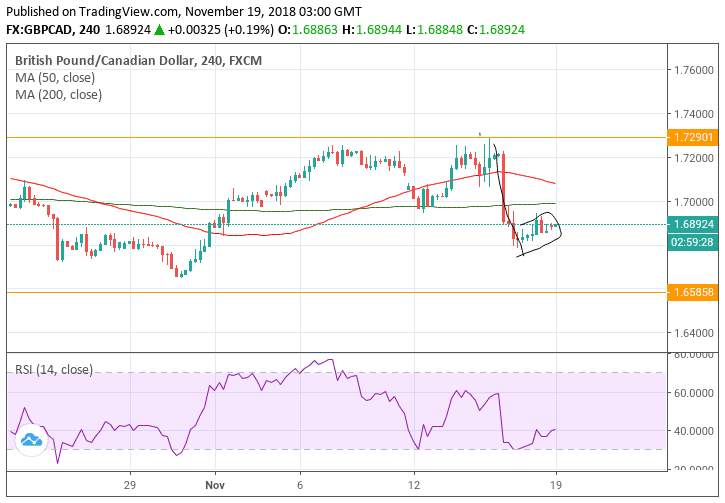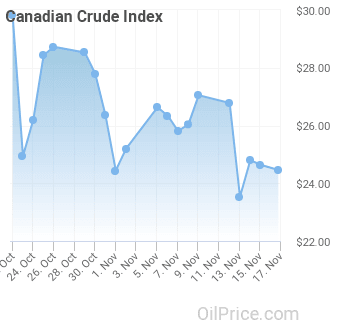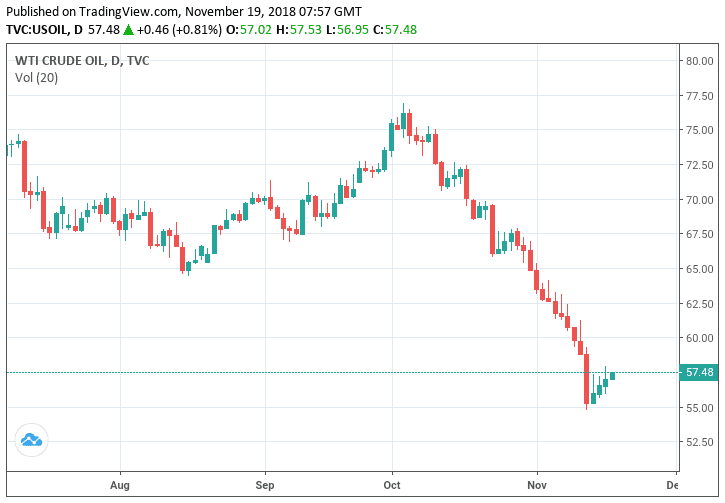Pound-Canadian Dollar Rate Earmarked to Continue Falling Within the Range
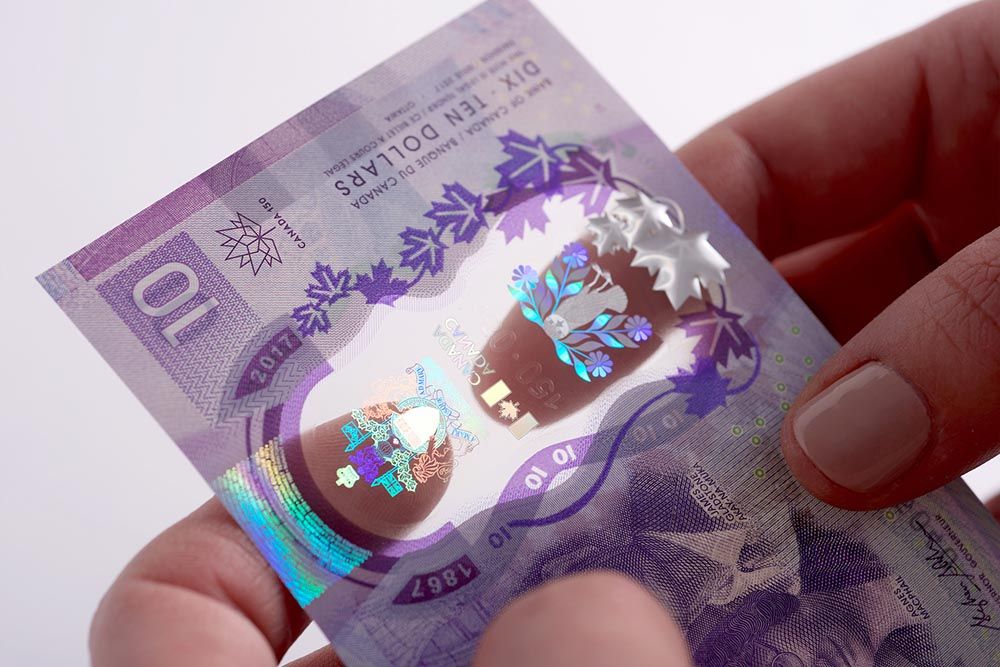
Image © Bank of Canada
- GBP/CAD is descending within a medium-term range
- It is forecast to fall to the range floor
- Brexit news is set to dominate the Pound; CAD to be driven by inflation data
Sterling starts the new week on a firmer footing against the Canadian Dollar with 1 GBP buying 1.6933 CAD amidst a broader pickup in Sterling exchange rates.
We put the better tone in Sterling down to expectations that further concessions might be squeezed out of the E.U. to ensure the Brexit deal struck last week can actually come into force.
The Pound-to-Canadian Dollar exchange rate sold off sharply at the end of last week as renewed fears of the UK crashing out of the EU without a deal weighed on the Sterling side of the pair.
GBP/CAD has been trading in a sideways range ever since it based in August. Last week we noted how it had risen up and touched the range highs at 1.73, since then it has retreated back down into the middle of the range again, where it is currently trading at the start of the new week.
The steepness of the descent since the last touch of the range ceiling strongly suggests further downside is on the cards. We see a strong possibility of the short-term downtrend extending in the week ahead towards the range lows at circa 1.66.
The most recent decline, viewed on the 4hr chart, has formed a bearish flag pattern which further indicates the potential for more losses.
Bearish flags are composed of steep declines - the ‘flag pole’, followed by a rectangular consolidation zone, or ‘flag square’. The length of the pole is used as a guide to determine the extent of the follow-through lower after the square has completed. In this case it suggests a move down to the range floor at 1.6600-50.
A break below the 1.6784 Nov 15 lows would probably signal the flag pattern was triggering and lead to an extension to the aforesaid target zone at the range floor.
Momentum, as measured by RSI, in the bottom panel, is neither particularly bearish or bullish so offers little extra insight - crucially, however, it does not contradict the bearish bias indicated by the flag.
Advertisement
Bank-beating GBP/CAD exchange rates: Get up to 5% more foreign exchange by using a specialist provider to get closer to the real market rate and avoid the gaping spreads charged by your bank when providing currency. Learn more here
The Canadian Dollar: What to Watch
Oil is a major driver of the Canadian Dollar due to its status as the country's primary export - higher crude oil prices result in greater demand for the currency driving up its value.
Nevertheless, it should also be borne in mind that the type of oil found in Canada, called West Canada Select (WSC), has its own price and it's own fundamental drivers independent of the common WTI Crude variety. It is also generally substantially cheaper.
WSC recently lost value after a crucial pipeline which would have enabled broader distribution was rejected on environmental grounds; it is also thicker than other types and requires more refining.
That does not mean it trades completely independently of general oil market drivers either, and global supply and demand remain key factors.
The global oil market is in a downtrend after having lost over 20% of its value since its peak at the start of October and this is likely to continue in the week ahead and be a contributing headwind both to the Canadian Dollar and the price of WCS.
As far as hard data goes, the main release in the week ahead is probably the inflation rate, in October, out on Friday at 14.30 GMT. Analysts expect the broad inflation rate to remain at 2.2% compared to a year ago. A higher-than-expected rate would appreciate the Canadian Dollar and vice-versa for a lower rate, because higher inflation puts pressure on the central bank to increase interest rates, and higher interest rates attract greater inflows if foreign capital.
Retail sales in September is out at the same time and is forecast to show a 0.2% rise compared to -0.4% previously. Retail sales is often a good indicator of consumer spending and therefore economic growth, since in most economies consumption is the main driver of growth.
The Pound: What to Watch
All eyes will be on prime minister Theresa May and whether she can hold onto power.
Importantly, there is confirmation that the U.K. can get further concessions from the E.U. - this is exactly what is required to allow the DUP and Conservative party opponents back on side.
In a Sky News interview May says the key to the outlook would be the next seven days, when her negotiators would be going back to E.U. officials and hammering out the "future relationship".
She will also be visiting Brussels, she added, and will talk to E.U. Commission president Jean-Claude Juncker as part of the week's discussions.
May needs further concessions and the E.U. can quite clearly see the plan they have brokered requires some help. This news is a Pound -positive development.
Conservative rebels seeking May's ouster might this week eventually muster enough votes - 48 are needed - to force a vote of no confidence in the Prime Minister. This would be a Pound-negative development.
If May loses the vote she is out, if she survives she is immune to another challenge for a year.
"To unseat PM May successfully would require a majority and it is much less clear
that this number would be reached," says MUFG's Loew. "If PM May was surprisingly defeated in a leadership challenge, we would expect the Pound to fall by a further 3% to 5%. It would heighten concerns over a 'No Deal' outcome."
May winning a vote would be Pound-positive as it does suggest the room for manoeuvre by 'hard brexiteer' opponents is fast running out.
There were expectations that May would be subject to a no confidence vote on Friday, November 16, but the threshold has yet to be met, suggesting the rebellion might in fact be stalling. As of the time of writing there still appears to be too few letters to trigger a vote of no confidence.
If it does stall, we see it as a positive trigger for a potential, partial, recovery in the currency.
A key event in the week ahead for the Pound is probably the Bank of England Inflation Report hearings conducted by members of the House of Commons Treasury Select Committee, a parliamentary body charged with oversight of the public finances.
The comments from the Bank of England at this hearing, especially in relation to the trajectory of the economy and the effect of Brexit, could impact the Pound.
Recent economic data including CPI and retail sales were lower-than-expected, while growth data suggests a slowdown in activity into year-end.
The hearings are on Monday at 11.00 GMT.
The other key release is the CBI industrial trends survey out at 00.00 on Monday, November 19. Although unlikely to move markets on their own, CBI surveys are usually good leading indicators of future economic activity and, therefore, contribute to formulating the overall economic backdrop in which to access the Pound.
Public sector net borrowing is out on Wednesday at 10.30. Borrowing came out at -3.26bn on October. Overall government borrowing has fallen over recent years.
Advertisement
Bank-beating GBP/CAD exchange rates: Get up to 5% more foreign exchange by using a specialist provider to get closer to the real market rate and avoid the gaping spreads charged by your bank when providing currency. Learn more here

